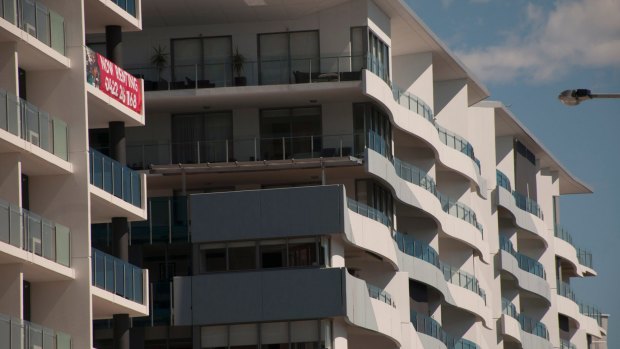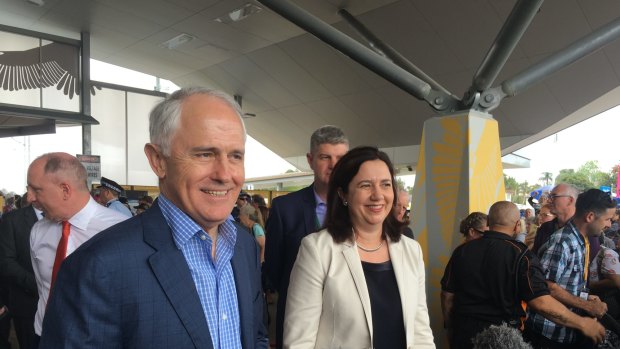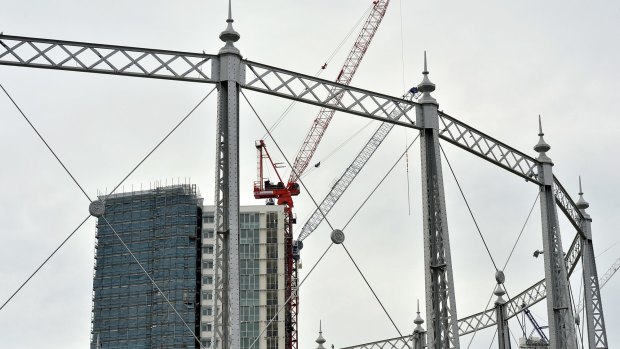This was published 8 years ago
Tripling of Brisbane units since turn of the century consigns backyards to history
By Cameron Atfield
Council data has revealed an almost three-fold increase in the number of units in Brisbane since the turn of the century, as more and more people forgo the great Australian backyard.
The Brisbane City Council database of rateable properties within the local government area showed the number of units had increased 158.33 per cent, from 54,304 on January 1, 2001 to 140,281 on the same date this year.

Ms Douglas said she wasn't surprised Carindale was the most expensive place to rent in Brisbane. Credit: Robert Shakespeare
Unsurprisingly, most of that growth was in the inner-city suburbs, with a 531.8 per cent increase in the CBD alone, up from 1192 to 7531.
Strong growth was also seen in South Brisbane (414.3 per cent with 3766 new units), Fortitude Valley (1021.85 per cent with 3648 new units) and West End (480.27 per cent, with 2800 new units).
The biggest increase outside of the inner city was at Chermside, which saw a 245.63 per cent increase, from 835 to 2886 units in the same time period.
Detached homes, meanwhile, saw just a 15.26 per cent increase, from 259,399 on January 1, 2001, to 298,995 in 2017.
Also not surprisingly, most of that growth occurred in Brisbane's few remaining suburbs with green fill options.
Forest Lake topped the list of new houses in Brisbane, with 2662 since 2001 – an increase of 52.45 per cent.
That was followed by Wakerley (433.86 per cent with 1935 new houses), Parkinson (118.82 per cent with 1667 new houses) and Fitzgibbon (177.06 per cent with 1181 new houses).
At the turn of the century, in 2001, units accounted for 17.31 per cent of the dwellings in Brisbane. On New Year's Day 2017, 31.93 per cent of dwellings in Brisbane were units.
That has caused much publicised pressure on utilities and services, such as inner-city schools struggling to cope with an influx of new students.
Property Council of Australia Queensland executive director Chris Mountford said the two-speed growth when it came to units and detached houses was not surprising when it came to Brisbane.
"There's very few green field opportunities left within Brisbane City Council's council area, so I imagine a lot of what's coming through in terms of additional houses is a bit of what's occurring is, for example, 800 square metre blocks being cut up into two 400s," he said.
"We've known for a while now, even when you go back to the early South East Queensland Regional Plans, that the big focus in the Brisbane City Council area is going to be around greater levels of infill development, which largely means apartments, townhouses and the like."
The significant growth in detached housing had occurred, and would continue to occur, elsewhere in south-east Queensland, Mr Mountford said.
"There are large developments occurring out at Springfield, Ripley, Yarrabilba, Caloundra South on the Sunshine Coast and, over the past 20 years, others like North Lakes have come through in other local government areas," he said.
For Brisbane, though, Mr Mountford said the focus through necessity would continue to be on infill development.
And despite Brisbane's slowing unit market, Mr Mountford said the long-term prospects were still good and dismissed concerns about a market oversupply.
"Property typically moves in cycles and I think it's fairly clear to everybody that we've passed the construction peak of this cycle in and around apartments," he said.
"It's dangerous to think of any housing market as a singular market. There is different product being produced in different locations across the city and demand will follow that differently over time.
"Certainly, if you take a medium-term point of view, five-plus years, there's no doubt in the future we'll need more than what's been produced up until today.
"Things will pick up again in the future."
Moving a growing Brisbane
Such residential growth puts incredible pressure on a city's transport systems and, when it came to public transport, Robert Dow said Brisbane had not coped well.
"(Planners) been very tardy in anticipating demand and we're reaching a situation where we're really starting to get significant road congestion issues," he said.
"There's not much room left on the roads at peak, so we really have to get people on to mass transit where we can."
Mr Dow, from public transport advocacy group Rail: Back on Track, said the wider Brisbane region was left playing catch-up after years of inaction.
"We have only started thinking about new railway lines recently – the Springfield Central was the first new railway line other than the Gold Coast, which was really re-establishing a previous railway line – after almost 100 years of doing nothing," he said.
"The rail network in Brisbane has not really been improved in terms of the areas served as the population expanded, until recently.
"We've seen Springfield Central, which has worked out really well. Kippa-Ring has had problems, clearly, related to 'rail fail' and signalling issues on the branch line, but they will be resolved in time and that line will be worth gold.
"We need to be thinking about how we're going to service these areas."

The Prime Minister and Premier at the opening of the Redcliffe Peninsula line last October.Credit: Cameron Atfield
Mr Dow said the unit growth in the central city was good news for public transport users moving into the inner-circle, as they had access to regular and reliable services.
But it was not such good news for inner-city residents with cars, RACQ advocacy general manager Paul Turner said, was the massive residential growth had caused all sorts of trouble on the roads.
"It exacerbates the traffic and congestion issues we have around the CBD and high-traffic areas, because by their very nature, they're the areas these units are built," he said.
"So you end up with these quite reasonable planning decisions to base high-density living around transport modes or where the work is.
"In Brisbane's case, often that is the four axes of the compass, and you end up at Chermside, Indooroopilly, Mount Gravatt and Carindale, as well as the inner-city."
That put pressure on both the road and public transport connections to those hubs.
Moving forward

Newstead and other inner-city suburbs have seen enormous growth in unit construction.Credit: Bradley Kanaris
"It's a difficult city, transport-wise, because of the river," Mr Turner said of Brisbane.
"A lot of money has been spent on tunnels and bridges over the years and we do have some real challenges ahead as the density increases in the CBD and the surrounds."
No matter the quality of public transport, Mr Turner said Brisbane residents would always want to use personalised transport, such as cars.
"Where Brisbane is different to other cities is that in many, many other cities, if you live in the inner-city you won't have a car at all and probably won't need access to one," he said.
"Bondi Beach is easy to get to in Sydney and, in Melbourne, you can get on a train to the beach.
"I think most Brisbane residents would still like to have access to a vehicle and that means the city has to cater for that."
Innovative solutions were needed, Mr Turner said, and both the city and its people would have to make some adjustments.
"One thing that will happen is car sharing schemes will be set up as part of a body corporate," he said.
"So rather than every unit having a personal vehicle underneath the unit block, you will get your unit and you will be a member of a car sharing scheme – a pool of cars you will all have access to and use as you need them."
As for the outer suburbs, Mr Dow said public transport options continued to be poor.
Eventually, Mr Dow said, the proposed Brisbane Metro would need to be extended north to Chermside – a high-growth area without a rail connection – and east to Carindale.
"They have got a reasonable bus service at the moment and we see great potential for Chermside in terms of the Brisbane Metro plan, which is now bi-articulated buses," he said.
"I would see that bi-articulated buses would eventually be running to Chermside (as part of the metro) and I also see that they will be running to Carindale.
"They will be running not necessarily on busways, but on transitways. It's too expensive to build those busways."
Transitways provide dedicated peak-hour lanes for public transport and featured in Labor's failed bid to wrest control of City Hall from the Liberal National Party last year.
The most critical transport need

Cross River Rail's proposed Albert Street Station will be the first new rail station in the CBD for 100 years.
The most critical piece of new infrastructure, Mr Dow and Mr Turner agreed, was the long-promised Cross River Rail project, which would provide an underground river crossing and help alleviate the rail bottleneck on the Merivale Bridge.
Cross River Rail was first put into the public arena on March 5, 2007, when this reporter revealed the plans in the now-defunct mX commuter paper.
"That highlights what the problem has been," Mr Dow said.
"We've had lots of promises, lots of plans, lots of visions, lots of video presentations but that's it. We haven't had anything really happening."
Mr Dow said Cross River Rail, along with the council's revised Brisbane Metro scheme, had the potential to be game-changers.
"The solution now for south-east Queensland and Brisbane is for Brisbane Metro and Cross River Rail to be looked at as an integrated transport solution, rather than two independent projects," he said.
"They are independent in the sense of BCC's running one and the state government's running the other, but they go together very well now and they're integrated in an operational sense."
Mr Turner said "we've still got some work to do" if the region was to cater to the growth expected in south-east Queensland.
"It's not something we've done particularly well so far," he said.
"We've attached a lot of large housing estates to the Bruce Highway and M1 and they're commuter estates, essentially.
"That hasn't helped."